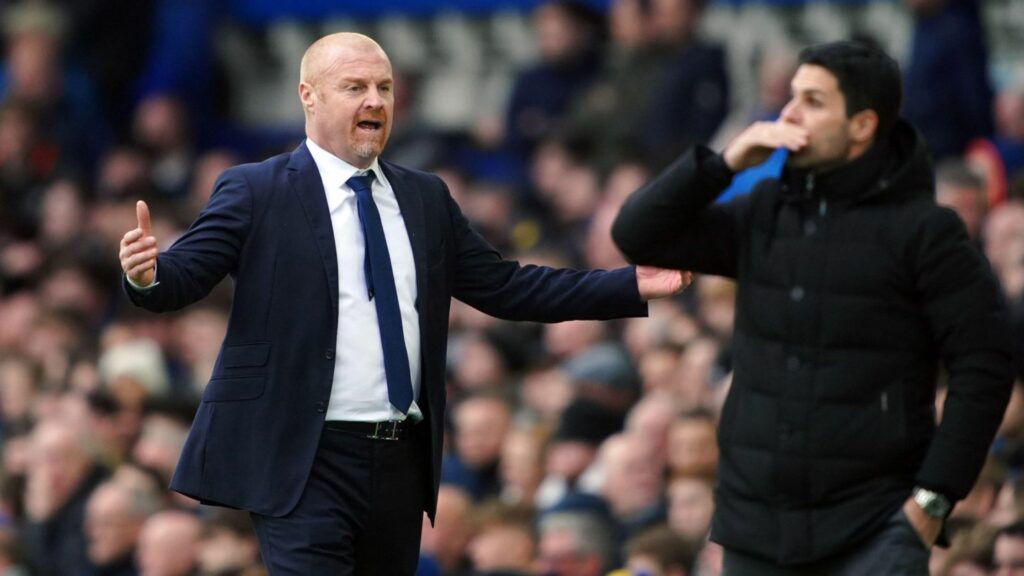Sean Dyche has been tasked, once again, with trying to save a club from the brink of Premier League relegation.
His appointment as manager of Everton may have come as a surprise, but early signs have been positive, with Dyche earning victories against Arsenal and Leeds.
What are Sean Dyche’s tactics, and how does he plan to employ his philosophy in his new job? Let’s take a look at what we know so far.
Sean Dyche’s Pre-Everton Career
Sean Dyche had a successful playing career as a center-half, making his professional debut in 1990 for Chesterfield. He went on to play for several other clubs, including Bristol City, Luton Town, Millwall, Watford, and Northampton Town. Quite significantly, perhaps, he was promoted with three of his six clubs.
Dyche began his coaching career with Watford’s youth team and was later promoted to become the Hornets’ manager in June 2011. He left Watford ahead of the 2011/12 campaign and was announced as Burnley’s manager in October 2012. He guided Burnley to a second-place finish in the 2013/14 Championship, earning automatic promotion to the Premier League.
Burnley finished 16th in the top tier the following season and was seventh in 2017/18, their best-ever Premier League finish under Dyche’s leadership. Dyche left Burnley in April 2022, with the club in 18th place, four points from safety.
He was appointed as manager of Everton in early 2023, replacing Frank Lampard under whom the club had flirted with relegation worries for most of his reign.
Dyche’s football philosophy
At Burnley, Dyche’s philosophy revolved around a 4-4-2 structure, surrounding compact defensive systems and an adventurous long-passing game. He recruited players within that style, such as Nick Pope and James Tarkowski. They’ve confirmed themselves as exceptional signings.
Dyche’s teams are known for their strong set-piece routines. They rely on their aerial prowess to cause problems in the opposition box from corners and free-kicks. This has allowed them to compete against more talented opponents and earn crucial points in tight games.
Sean Dyche’s tactics at Burnley have been centered on a long-passing 4-4-2 system, which he adopted, most likely, due to his experience as a centre-back in the 1990s. The system has remained rigid and has seen the team lump the ball forward quickly, resulting in little change in shape even in attack.
The centre-forwards are tasked with knocking long passes down to the midfielders behind them or their striking partner, allowing for subsequent switches of play to the wide areas and crosses into the box. However, Dyche has adopted a different approach at Everton, prioritizing set pieces, and making the team more effective and dominant from corner-kicks.
Sean Dyche’s tactics at Everton
Under Dyche’s reign, Everton has become more direct and less possession-focused, and his back-to-basics tactics helped them secure a vital win over Arsenal in his first game in charge. The success of Dyche’s system is in sheer organization, making their high level of coordination and control look seamless.
Everton’s players consistently look for space, and they put pressure one at a time immediately as the ball enters their own half. Dyche can depend on his defensive leaders, James Tarkowski, and Conor Coady to help implement his system. However, Michael Keane, who played for Burnley for two and a half years before moving to Everton, had recently been in poor form.
Everton in defense in Dyche’s reign
Dyche’s system was successful due to its sheer organization, and the principles behind it were never overly complicated. Despite this, the team displayed a high level of coordination and control that made it look seamless.
Against Arsenal, Liverpool and Leeds, in a 4-5-1 formation, Dyche’s team adjusted their positioning in relation to the ball, opposition, and space, with central midfielders occasionally pushing up to apply pressure and create a fleeting 4-4-2 formation.
In other areas of the pitch, players would immediately pressure the ball as soon as it entered their zone. Tarkowski and Coady led the organization at the back, consistently shuffling and communicating to maintain the defensive structure. The level of coordination between them and their full-backs was tremendous.
In essence, Dyche successfully implemented a simple system that allowed his players to make sound decisions in relation to ball, opposition, teammates, and space. This was no easy feat, but Dyche had the right players at his disposal, and he has brought more togetherness to the team than anyone else before him.
Everton in the build-up phase
During the build-up phase against Arsenal, Everton employed a mix of long passes, vertical counter-attacks, and aerial threats from set-pieces. Everton attempted only 15 dribbles against Arsenal, with a mere six being successful. This is in stark contrast compared to their average of 22.95 per 90 minutes under Lampard.
Every time Everton won the ball, they looked to go forward, finding a long pass to Dominic Calvert-Lewin as the target man up front. Others joined the attacking phase, seeking space through the center of the pitch, while full-backs overlapped their wingers to create chaos down the wide areas.
Everton in attack
Calvert-Lewin’s fantastic aerial presence helped to unlock wide attacks, as he often knocked on long passes to his wingers, who then delivered crosses to late-arriving central midfielders. Dyche could use Calvert-Lewin as the ideal striker for this Everton side. In future matches, the team must find ways to free up their ‘Target Man’ and stop the opposition from finding ways to mark him.
Neal Maupay and Demarai Gray could also partner with Calvert-Lewin up-front if Dyche opts to revert to his classic 4-4-2 system. Furthermore, the aggressive and attacking full-backs look to offer cross into the penalty area constantly. Meanwhile, midfielders like Amadou Onana and Abdoulaye Doucoure act almost like box-to-box midfielders looking to pressure defenses on the counter-attack.
Will Everton avoid the drop under Dyche’s leadership?
Dyche’s system was successful due to its simplicity, and Everton executed it perfectly against Arsenal. The manager’s reign has already started better than many expected. The team has racked up 6 important points during Dyche’s first three matches.
The experienced manager has opted for a set of tactics that play within The Toffees’ strengths implemented, often very successfully at Burnley.
Add to this the fact that Everton, despite their recent misfortune, has a highly talented squad at their disposal.
Yes, Sean Dyche can use his tactics and managerial acumen to stir the ship around. Will this be enough to help Everton thrive in the long-term? Only time can tell.














